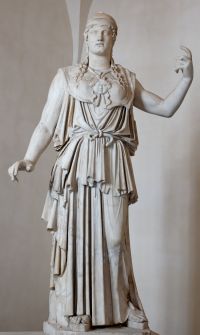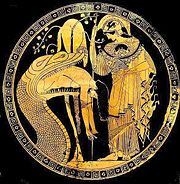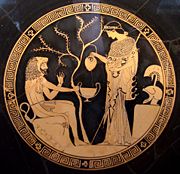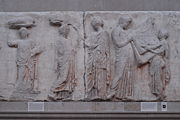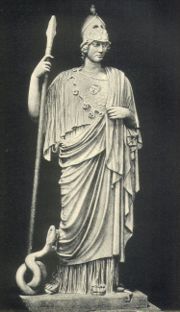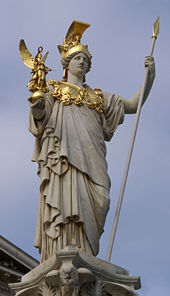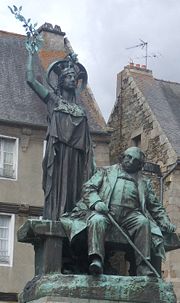Athena
2008/9 Schools Wikipedia Selection. Related subjects: Divinities
In Greek mythology, Athena (also called Athene, Attic: Ἀθηνᾶ, Athēnâ, or Ἀθήνη, Athḗnē; Doric: Ἀσάνα, Asána; Latin: Minerva) is the shrewd companion of heroes and the goddess of heroic endeavour. She is the patron of Athens, which built the Parthenon to worship her. In a temple at Phrixa in Elis, which was reportedly built by Clymenus, she was known as Cydonia..
Overview
Athena's cult seems to have existed from very early times as the patron of Athens and was so persistent that myths about her were rewritten often to adapt to cultural changes over the multiple eras of Ancient Greek traditions. The Greek philosopher, Plato (429–347 B.C.E.), identified her with the Libyan deity, Neith, who was the war-goddess and huntress deity of the Egyptians since the ancient predynastic period. She also would come to be known as the goddess of wisdom as philosophy became applied to cult in the later fifth century and Classical Greece. She was the patroness of weaving especially, and other crafts (Athena Ergane), and the more disciplined side of war, where she led the battle (Athena Promachos). The metalwork associated with the creation of weapons fell under her patronage. Athena's wisdom also includes the cunning intelligence ( metis) of such figures as Odysseus.
She is attended by an owl, and is often accompanied by the goddess of victory, Nike, whom in established icons she offers upon her extended hand. Wearing a breastplate of either goatskin or snake skin called the Aegis, which in late myths is said to have been given to her by her father, Zeus although she was associated with this long before in other cultural contexts. She often is shown helmeted and with a shield bearing the Gorgon head, the hallmark of the early goddess cult in Greece that was given the highest position in the apex of the front facade of the Parthenon. Her shield was later said to be a votive gift of Perseus. A serpent often accompanies this goddess and frequently is depicted at the base of the staff of her lance. The sea and ships as well as horses and chariots are associated with her, but with less frequency.
Athena is an armed warrior goddess, and appears in Greek mythology as a helper of many heroes, including Odysseus, Jason, and Heracles. In Classical Greek myths she never had a consort or lover, and thus, often was known as Athena Parthenos ("Athena the virgin"), hence the name of her most famous temple, the Parthenon, on the Acropolis in Athens. In a remnant of archaic myth, she was the mother or adoptive mother of Erichthonius by the attempted rape by Hephaestus, which failed. Other variants relate that the serpent who accompanied Athena, also called Erichthonius, was born to Gaia, Earth, when the rape failed and the semen landed on Gaia, impregnating her, and that after the birth he was given to Athena by Gaia.
In her role as a protector of the city, Athena was worshiped throughout the Greek world as Athena Polias ("Athena of the city"). She had a special relationship with Athens, as is shown by the etymological connection of the names of the goddess and the city.
Mythology
Birth
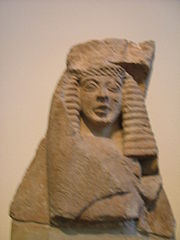
In The Greek Myths by Robert Graves (8.a, ff.) he notes early myths about the birth of Athena, in which she is described as a goddess from Libya whose worship came to the Greeks from Crete after arriving there as early as 4,000 BC. Graves also states that Hesiod (c. 700 BC) relates that Athena was a parthenogenous daughter of Metis, wisdom or knowledge, a Titan who ruled the fourth day and the planet Mercury. Other variants relate that although Metis was of an earlier generation of the Titans, Zeus became her consort when his cult gained dominance. In order to avoid a prophecy made when that change occurred, that any offspring of his union with Metis would be greater than he—Zeus is said to have swallowed Metis to prevent her from having offspring, but she already was pregnant with Athena. Metis gave birth to her and nurtured her inside Zeus until Athena burst forth from his forehead fully armed with weapons given by her mother.
In the late Classical Greek myths, Athena is most commonly described as the daughter of Zeus, born from his head after he swallowed her pregnant mother. The weapons for which she is most famous are the thunderbolt and the Aegis, which she and Zeus were said to share exclusively.
The Olympian version
Although at Mycenaean Knossos Athena appears before Zeus does—in Linear B, as a-ta-na po-ti-ni-ja, "Mistress Athena"— in the Classical Olympian pantheon, Athena was remade as the favorite daughter of Zeus, born fully armed from his forehead after he swallowed her mother, Metis. The story of her birth comes in several versions. In the one most commonly cited, Zeus lay with Metis, the goddess of crafty thought and wisdom, but he immediately feared the consequences. It had been prophesied that Metis would bear children more powerful than the sire, even Zeus himself. In order to forestall these dire consequences, after lying with Metis, Zeus "put her away inside his own belly;" he "swallowed her down all of a sudden," He was too late: Metis had already conceived a child.
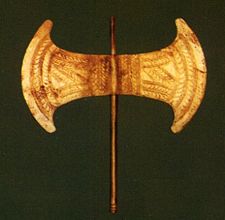
Eventually it came to be that Zeus was in great pain; Prometheus, Hephaestus, Hermes, or Palaemon (depending on the sources examined) cleaved Zeus's head with the double-headed Minoan axe, the labrys. Athena leaped from Zeus's head, fully grown and armed—with a shout, "and pealed to the broad sky her clarion cry of war. And Ouranos trembled to hear, and Mother Gaia..." ( Pindar, Seventh Olympian Ode). As noted above the Minonan culture of Crete was thought by Plato to have been a source from which the cult of Athena was introduced from Lybia during the dawn of Greek culture.
Classical myths thereafter noted that Hera was so annoyed at Zeus producing a child—apparently on his own—that she caused herself to conceive and bear Hephaestus by herself. After the appearance of this variant it becomes stated that Metis thereafter never bore any more children and, that Zeus persisted as supreme ruler of Mount Olympus. The Greek myths became static at this point, not changingbefore the ancient culture declined and its religion faded from practice.
Other origin tales
Fragments attributed by the Christian Eusebius of Caesarea to the semi-legendary Phoenician historian Sanchuniathon, which Eusebius thought had been written before the Trojan war, make Athena instead, the daughter of Cronus, a king of Byblos who is said to have visited 'the inhabitable world' and bequeathed Attica to Athena. Sanchuniathon's account would make Athena, as was Hera, the sister of Zeus, not his daughter.
Pallas Athena
The major competing tradition regarding Athena's parentage involves some of her more mysterious epithets: Pallas, as in Ancient Greek Παλλάς Άθήνη (also Pallantias) and Tritogeneia (also Trito, Tritonis, Tritoneia, Tritogenes). A separate entity named Pallas is invoked – whether Athena's father, sister, foster-sister, companion, or opponent in battle. In every case, Athena kills Pallas, accidentally, and thereby gains the name for herself.
When Pallas is Athena's father the events, including her birth, are located near a body of water named Triton or Tritonis, the result of an etymology of Tritogeneia from Tritonis. When Pallas is Athena's sister or foster-sister, Athena's father or foster-father is Triton, the son and herald of Poseidon. But Athena may be called the daughter of Poseidon and a nymph named Tritonis, without involving Pallas. Likewise, Pallas may be Athena's father or opponent, without involving Triton. On this topic, Walter Burkert says "she is the Pallas of Athens, Pallas Athenaie, just as Hera of Argos is Here Argeie. For the Athenians, Burkert notes, Athena was simply "the Goddess", he thea, certainly an ancient title.
Athena Parthenos: Virgin Athena
Athena never had a consort or lover and thus, also was known as Athena Parthenos, "Virgin Athena." Her most famous temple, the Parthenon, on the Acropolis in Athens takes its name from this title. It was not merely an observation of her virginity, but a recognition of her role as enforcer of rules of sexual modesty and ritual mystery. This role is expressed in a number of stories about Athena. Marinus reports that when Christians removed the statue of the Goddess from the Parthenon, a beautiful woman appeared in a dream to Proclus, a devotee of Athena, and announced that the "Athenian Lady" wished to dwell with him.
Erichthonius
Hephaestus attempted to rape Athena, but she eluded him. His semen fell on the ground, and Erichthonius was born from the Earth, Gaia. Athena then raised the baby as a foster mother.
Athena put the infant Erichthonius in a small box (cista) which she entrusted to the care of three sisters, Herse, Pandrosus, and Aglaulus of Athens. The goddess didn't tell them what the box contained, but warned them not to open it until she returned. One or two sisters opened the cista to reveal Erichthonius, in the form (or embrace) of a serpent. The serpent, or insanity induced by the sight, drove Herse and Pandrosus to throw themselves off the Acropolis. Jane Harrison (Prolegomena) finds this to be a simple cautionary tale directed at young girls carrying the cista in the Thesmophoria rituals, to discourage them from opening it outside the proper context.
Another version of the myth of the Athenian maidens is told in Metamorphoses by the Roman poet Ovid (43 BC – 17 AD); in this late variant Hermes falls in love with Herse. Herse, Aglaulus, and Pandrosus go to the temple to offer sacrifices to Athena. Hermes demands help from Aglaulus to seduce Herse. Aglaulus demands money in exchange. Hermes gives her the money the sisters had already offered to Athena. As punishment for Aglaulus's greed, Athena asks the goddess Envy to make Aglaulus jealous of Herse. When Hermes arrives to seduce Herse, Aglaulus stands in his way instead of helping him as she had agreed. He turns her to stone.
With this mythic origin, Erichthonius became the founder- king of Athens, where many beneficial changes to Athenian culture were ascribed to him. During this time, Athena frequently protected him.
Medusa and Tiresias
In a late myth, Medusa, unlike her two sister-Gorgons, came to be thought of by the Classical Greeks during the fifth century as, mortal and extremely beautiful, but she had sex with — or was raped by — Poseidon in a temple of Athena. Upon discovering the desecration of her temple, Athena changed Medusa's form to match that of her sister Gorgons as punishment. Medusa's hair turned into snakes, her lower body was transformed also, and meeting her gaze would turn any living creature to stone. In the earliest of myths there is but one Gorgon and the only snakes were two wrapped around her waist as a belt.
In one version of the Tiresias myth, Tiresias stumbled upon Athena bathing, and was blinded by her nakedness. To compensate him for his loss, she sent serpents to lick his ears, which gave him the gift of prophecy.
Lady of Athens
Athena competed with Poseidon to be the patron deity of Athens, which was yet unnamed, in a version of one founding myth. They agreed that each would give the Athenians one gift and that the Athenians would choose the gift they preferred. Poseidon struck the ground with his trident and a spring sprang up; this gave them a means of trade and water—Athens at its height was a significant sea power, defeating the Persian fleet at the Battle of Salamis—but the water was salty and not very good for drinking. (In an alternate version, Poseidon offered the first horse to the citizens, but horses also are associated with Athena in some myths.) Athena, however, offered them the first domesticated olive tree. The Athenians (or their king, Cecrops) accepted the olive tree and with it the patronage of Athena, for the olive tree brought wood, oil, and food. Robert Graves was of the opinion that "Poseidon's attempts to take possession of certain cities are political myths" which reflect the conflict between matriarchical and patriarchical religions. Athena also was the patron goddess of several other Greek cities, notably, Sparta.
Counselor
Later myths of the Classical Greeks relate that Athena guided Perseus in his quest to behead Medusa. She instructed Heracles to skin the Nemean Lion by using its own claws to cut through its thick hide. She also helped Heracles to defeat the Stymphalian Birds, and to navigate the underworld so as to capture Cerberos.
In another late story, it is said that Odysseus' cunning and shrewd nature quickly won Athena's favour. In the realistic epic mode, however, she largely is confined to aiding him only from afar, as by implanting thoughts in his head during his journey home from Troy. It is not until he washes up on the shore of an island where Nausicaa is washing her clothes that Athena arrives personally to provide more tangible assistance. She appears in Nausicaa's dreams to ensure that the princess rescues Odysseus and plays a role in his eventual escort to Ithaca.
Athena appears in disguise to Odysseus upon his arrival, initially lying and telling him that Penelope, his wife, has remarried and that he is believed to be dead; but Odysseus lies back to her, employing skillful prevarications to protect himself. Impressed by his resolve and shrewdness, she reveals herself and tells him what he needs to know in order to win back his kingdom. She disguises him as an elderly man or beggar so that he cannot be noticed by the suitors or Penelope, and helps him to defeat the suitors. She also plays a role in ending the resultant feud against the suitors' relatives.
Roman fable of Arachne
The fable of Arachne is a late Roman addition to Classical Greek mythology, that, of course, does not appear in the myth repertory of the Attic vase-painters. Arachne's name simply means spider (αράχνη). Arachne was the daughter of a famous dyer in Tyrian purple in Hypaipa of Lydia. She became so conceited of her skill as a weaver that she began claiming that her skill was greater than that of Athena herself.
Athena gave Arachne a chance to redeem herself by assuming the form of an old woman and warning Arachne not to offend the deities. Arachne scoffed and wished for a weaving contest, so she could prove her skill.
Athena wove the scene of her victory over Poseidon that had inspired her patronage of Athens. According to the Latin narrative, Arachne's tapestry featured twenty-one episodes of the infidelity of the deities: Zeus being unfaithful with Leda, with Europa, with Danaë.
Athena admitted that Arachne's work was flawless, but was outraged at Arachne's disrespectful choice of subjects that displayed the failings and transgressions of the deities. Finally, losing her temper, Athena destroyed Arachne's tapestry and loom, striking it with her shuttle, Arachne realized her folly and hanged herself. In Ovid's telling, Athena took pity on Arachne who was changed into a spider.
The fable suggests that the origin of weaving lay in imitation of spiders and that it was considered to have been perfected first in Asia Minor.
Cult and attributes
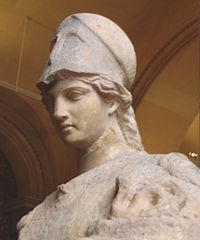
Athena's epithets include Άτρυτώνη, Atrytone (= the unwearying), Παρθένος, Parthénos (= virgin), and Ή Πρόμαχος, Promachos (the pre-fighter/-tress, i. e. she who fights in front).
In poetry from Homer, an oral tradition of the eighth or seventh century BC, onward, Athena's most common epithet is glaukopis (γλαυκώπις), which usually is translated as, bright-eyed or with gleaming eyes. The word is a combination of glaukos (γλαύκος, meaning gleaming, silvery, and later, bluish-green or gray) and ops (ώψ, eye, or sometimes, face). It is interesting to note that glaux (γλαύξ, "owl") is from the same root, presumably because of the bird's own distinctive eyes. The bird which sees well in the night is closely associated with the goddess of wisdom: in archaic images, Athena is frequently depicted with an owl perched on her head. The olive tree is likewise sacred to her. In earlier times, Athena may well have been a bird goddess, similar to the unknown goddess depicted with owls, wings, and bird talons on the Burney relief, a Mesopotamian terracotta relief of the early second millennium BC.
Other epithets include: Aethyta under which she was worshiped in Megara.. The word aithyia (αίθυια) signifies a diver, and figuratively, a ship, so the name must reference Athena teaching the art of shipbuilding or navigation.
Epithets
In the Iliad (4.514), the Homeric Hymns, and in Hesiod's Theogony, Athena is given the curious epithet Tritogeneia. The meaning of this term is unclear. It seems to mean " Triton-born," perhaps indicating that the sea-deity was her parent according to some early myths, or, less likely, that she was born near Lake Triton in Africa. This is the same location noted in The Greek Myths (8.a ff.), by Robert Graves as the possible location from which the worship of Neith was imported into Crete and then into Greece as the warrior goddess Athena at a very early date, perhaps as early as 3,500 BC.
Another possible meaning may be triple-born or third-born, which may refer to a triad or to her status as the third daughter of Zeus or the fact she was born from Metis, Zeus, and herself; various legends list her as being the first child after Artemis and Apollo, though other legends identify her as Zeus' first child. The later would have to be drawn from Classical myths, however, rather than earlier ones.
In her role as judge at Orestes' trial on the murder of his mother, Clytemnestra (which he won), Athena won the epithet Athena Areia.
Athena later was associated with the application of philosophy to cult in the fifth century during the Classical period. She remained the patroness of weaving, crafts, and the more disciplined side of war. Athena's wisdom encompasses the technical knowledge employed in weaving and metal-working, but also includes the cunning intelligence ( metis) of such figures as Odysseus.
Other epithets were Ageleia and Itonia.
The owl and the olive tree are sacred to her. She is attended by an owl, and often is accompanied by the goddess of victory, Nike. Although it is sometimes said to be a snake skin, wearing a goatskin breastplate called the Aegis that suggests a Lydian origin. The aegis later is interpreted to have been given to her by her father, Zeus, she often is shown helmeted and with a shield bearing the Gorgon head, again a symbol of earlier themes, later as a votive gift of Perseus. Athena is an armed warrior goddess and appears in later Greek mythology as the counselor of many heroes, including Heracles, Jason, and Odysseus.
Athena was given many other cult titles. She had the epithet Athena Ergane as the patron of craftsmen and artisans. With the epithet Athena Parthenos ("virgin"), Athena was worshiped on the Classical period Acropolis, especially in the festival of the Panathenaea. With the epithet Athena Promachos she led in battle. With the epithet Athena Polias ("of the city"), Athena was the protector of Athens and its Acropolis, but also of many other cities, including Argos, Sparta, Gortyn, Lindos, and Larisa.
She was given the epithet Athena Hippeia or Athena Hippia, horse as the inventor of the chariot, and was worshipped under this title at Athens, Tegea and Olympia. As Athena Hippeia she was given an alternative parentage: Poseidon and Polyphe, daughter of Oceanus. . In each of these cities her temple frequently was the major temple on the acropolis.
Athena often was equated with Aphaea, a local goddess of the island of Aegina, located near Athens, once Aegina was under Athenian's power. The Greek historian Plutarch (46 AD–120 AD) also refers to an instance during the Parthenon's construction of her being called Athena Hygieia ("healer"):
- A strange accident happened in the course of building, which showed that the goddess was not averse to the work, but was aiding and co-operating to bring it to perfection. One of the artificers, the quickest and the handiest workman among them all, with a slip of his foot fell down from a great height, and lay in a miserable condition, the physicians having no hope of his recovery. When Pericles was in distress about this, the goddess [Athena] appeared to him at night in a dream, and ordered a course of treatment, which he applied, and in a short time and with great ease cured the man. And upon this occasion it was that he set up a brass statue of Athena Hygeia, in the citadel near the altar, which they say was there before. But it was Phidias who wrought the goddess's image in gold, and he has his name inscribed on the pedestal as the workman of it.
In classical times the Callynteria, or “Feast of Adorning,” was observed every May, it was a festival lasting five days. During this period the Priestesses of Athena, or “Plyntrides,” performed a cleansing ritual within “the Erecththeum,” the personal sanctuary of the goddess. Here Athena's statue was undressed, her clothes washed, and body purified.
In Classical art
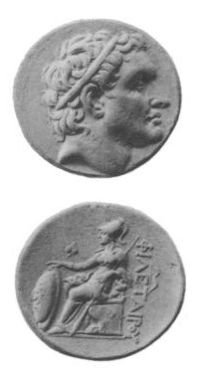
Classically, Athena is portrayed wearing full armor, with her helmet raised high on the forehead to reveal the image of Nike. Her shield bears at its centre the gorgoneion, the head of the gorgon, as does her aegis. It is in this standing posture that she was depicted in Phidias's famous lost gold and ivory statue of her, 36 m tall, the Athena Parthenos in the Parthenon. Athena also often is depicted with an owl sitting on one of her shoulders. The Mourning Athena is a relief sculpture that dates around 460 BC and portrays a weary Athena resting on a staff. In earlier, archaic portraits of Athena in Black-figure pottery, the goddess retains some of her Minoan-Mycenaean character, such as great bird wings although this is not true of archaic sculpture such as those of Aphaean Athena, where Athena has subsumed an earlier, invisibly numinous— Aphaea— goddess with Cretan connections in her mythos.
Other commonly received and repeated types of Athena in sculpture may be found in this list.
Apart from her attributes, there seems to be a relative consensus in late sculpture from the Classical period, the fifth century onward, as to what Athena looked like. Most noticeable in the face is perhaps the full round strong chin with a high nose that has a high bridge as a natural extension of the forehead. The eyes typically are somewhat deeply set. The unsmiling lips are usually full, but the mouth is fairly narrow, usually just slightly wider than the nose. The neck is somewhat long. The net result is a serene, serious, somewhat aloof beauty.
Name, etymology, and origin
Athena had a special relationship with Athens, as is shown by the etymological connection of the names of the goddess and the city. Athena was said to have won a contest with Poseidon, god of the Sea, over the city of Athens.
In Classical myths Zeus had decided that, in order to settle the feud, whoever gave the city the most useful gift would win ownership and patronage of the city. Poseidon gave the city a fountain of flowing water, but it was salty and was not much help to the people. Athena planted the first olive tree, which provided the people with food, firewood, and shade. She showed how to crush olives to make oil, that could then be used in a variety of ways. Athena's gift was the most useful, and she won patronage of the city. Athens was then named in her honour. The citizens of Athens built a statue of Athena as a temple to the goddess, which had piercing eyes, a helmet on her head, attired with a aegis or cuirass, and an extremely long spear. It also had a crystal shield with the head of the Gorgon on it. A large snake accompanied her and she held the goddess of victory in her hand.

Athena is associated with Athens, a plural name because it was the place where she presided over her sisterhood, the Athenai, in earliest times: "[Mycenae] was the city where the Goddess was called Mykene, and Mycenae is named in the plural for the sisterhood of females who tended her there. At Thebes she was called Thebe, and the city again a plural, Thebae (or Thebes, where the 's' is the plural formation). Similarly, at Athens she was called Athena, and the city Athenae (or Athens, again a plural)." Whether her name is attested in Eteocretan or not will have to wait for decipherment of Linear A.
Günther Neumann has suggested that Athena's name is possibly of Lydian origin; it may be a compound word derived in part from Tyrrhenian "ati", meaning mother and the name of the Hurrian goddess " Hannahannah" shortened in various places to "Ana". In Mycenaean Greek, at Knossos a single inscription A-ta-na po-ti-ni-ja /Athana potniya/ appears in the Linear B tablets from the Late Minoan II-era "Room of the Chariot Tablets"; these comprise the earliest Linear B archive anywhere. Although Athana potniya often is translated Mistress Athena, it literally means "the potnia of At(h)ana", which perhaps, means the Lady of Athens; Any connection to the city of Athens in the Knossos inscription is uncertain. We also find A-ta-no-dju-wa-ja /Athana diwya/, the final part being the Linear B spelling of what we know from ancient Greek as Diwia (Mycenaean di-u-ja or di-wi-ja): divine Athena also was a weaver and the deity of crafts. (see dyeus).
In his dialogue Cratylus, the Greek philosopher Plato, 428/427 BC – 348/347 BC, gives the etymology of Athena's name, based on the view of the ancient Athenians:
|
| Plato, Cratylus, 407b |
Thus for Plato her name was to be derived from Greek Ἀθεονόα, Atheonóa— which the later Greeks rationalised as from the deity's (theos) mind (nous).
The Greek historian, Herodotus (c. 484-425 BC), noted that the Egyptian citizens of Sais in Egypt worshipped a goddess whose Egyptian name was Neith; and they identified her with Athena. ( Timaeus 21e), ( Histories 2:170–175).
Some authors believe that, in early times, Athena was either an owl herself or a bird goddess in general: in Book 3 of the Odyssey, she takes the form of a sea-eagle. These authors argue that she dropped her prophylactic owl-mask before she lost her wings. "Athena, by the time she appears in art," Jane Ellen Harrison had remarked, "has completely shed her animal form, has reduced the shapes she once wore of snake and bird to attributes, but occasionally in black-figure vase-paintings she still appears with wings." Some authors claim that her tasselled aegis may be the remnants of wings. Others believe that it is scaly, indicating that it is snakeskin.
In post-classical culture
Athena (Minerva) is the subject of the $50 1915-S Panama-Pacific commemorative coin. At 2.5 troy oz (78 g) gold, this is the largest (by weight) coin ever produced by the U.S. Mint. This was the first $50 coin issued by the U.S. Mint and no higher was produced until the production of the $100 platinum coins in 1997. Of course, in terms of face-value in adjusted dollars, the 1915 is the highest denomination ever issued by the U.S. Mint.
For over a century a full-scale replica of the Parthenon has stood in Nashville, Tennessee, which is known as the Athens of the South. In 1990, a gilded 41 feet (12.5 m) tall replica of Phidias' statue of Athena Parthenos was added. The state seal of California features an image of Athena (or Minerva) kneeling next to a brown grizzly bear.
Athena is the symbol of the Darmstadt University of Technology, Germany.
She is the symbol of the United States Women's Navy and was depicted on their Unit Crest. A medal awarded to women who served in the Women Army Auxiliary Corps from 10 July 1942 to 31 August 1943, and to the Women Army Corps from 1 September 1943 to 2 September 1945 featured Athena on the front.
Athena's Helmet is the central feature on the United States Military Academy crest.
Athena is reported as a source of influence for feminist theologians such as Carol P. Christ.
Pallas Athena is the tutelary goddess of the international social fraternity Phi Delta Theta. Her owl is also a symbol of the fraternity.
The goddess also holds a special place in the traditions at Bryn Mawr College in Pennsylvania. A statue of Athena (a replica of the original bronze one in the archaeology library) resides in the Great Hall. It is traditional at exam time for students to leave offerings to the goddess with a note asking for good luck, or to repent for accidentally breaking any of the college's numerous other traditions. Athena's owl also serves as the mascot of the college.
A statue of the seated skeptical thinker Ernest Renan, shown to the left, caused great controversy when it was installed in Tréguier, Brittany. Renan's 1862 biography of Jesus had denied his divinity, and he had written the Prayer on the Acropolis addressed to the goddess Athena. The statue was placed next to the cathedral. Renan's head was turned away from the building, while Athena, beside him, was depicted raising her arm, which has been interpreted by some to indicate a challenge to the church. The installation was accompanied by a mass protest from local Roman Catholics and a religious service against the growth of skepticism and secularism.
